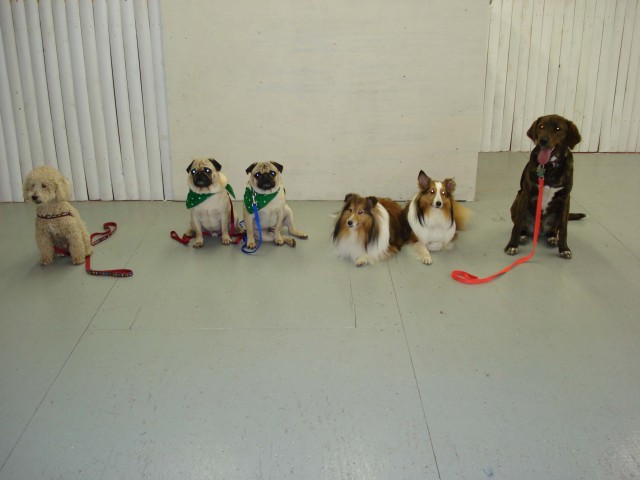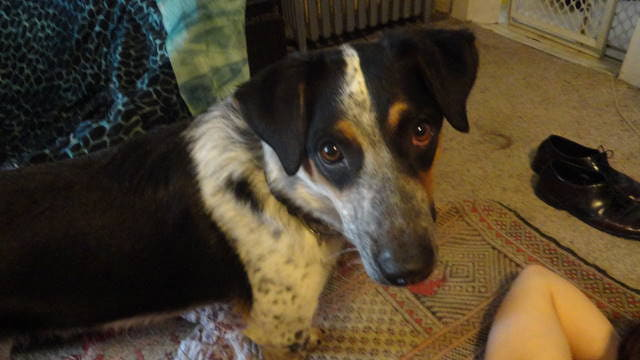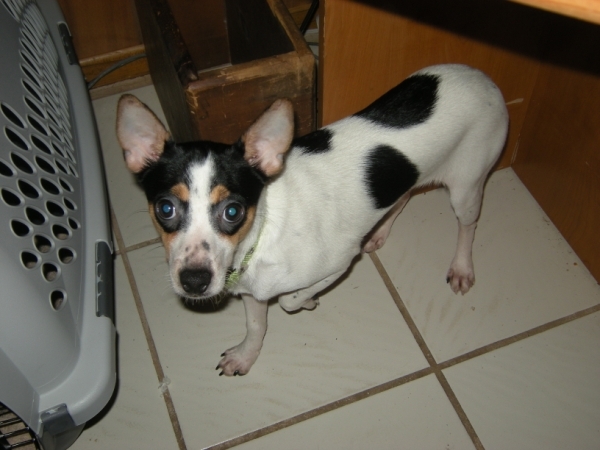QuestionQUESTION: Hello. I have a 3 year old male Shih tzu whose name is Bandit. We've had him since he was about 1.5 months old. The problem is Bandit has always peed in the house, it's like he was never trained. We just relocated from Florida to Georgia 1 month ago, we take him out 3 times daily, but he is still peeing in the house. We don't know what to do, we are getting tired of the pee on the carpets, and the smell, but we love him dearly. Please help...any suggestions are well appreciated.
ANSWER: Is he neutered?
---------- FOLLOW-UP ----------
QUESTION: No he is not neutered.
AnswerNeuter firstly. Then crate train. Entire dogs are much more likely to pee all over your house in a male dog way! :-)
Introduction
Providing your puppy or dog with an indoor kennel crate can satisfy many dogs' need for a den-like enclosure. Besides being an effective housebreaking tool (because it takes advantage of the dog's natural reluctance to soil its sleeping place), it can also help to reduce separation anxiety, to prevent destructive behavior (such as chewing furniture), to keep a puppy away from potentially dangerous household items (i.e., poisons, electrical wires, etc.), and to serve as a mobile indoor dog house which can be moved from room to room whenever necessary.
A kennel crate also serves as a travel cabin for you dog when travelling by car or plane. Additionally, most hotels which accept dogs on their premises require them to be crated while in the room to prevent damage to hotel furniture and rugs.
Most dogs which have been introduced to the kennel crate while still young grow up to prefer their crate to rest in or "hang-out" in. Therefore a crate (or any other area of confinement) should NEVER be used for the purpose of punishment.
We recommend that you provide a kennel crate throughout your dog's lifetime. Some crates allow for the removal of the door once it is no longer necessary for the purpose of training. The crate can be placed under a table, or a table top can be put on top of it to make it both unobtrusive and useful.
Preparing the Crate
Vari-Kennel type: Take the crate apart, removing the screws, the top and the door. Allow your pup to go in and out of the bottom half of the crate before attaching the top half. This stage can require anywhere from several hours to a few days. This step can be omitted in the case of a young puppy who accepts crating right away.
Wire Mesh type:Tie the crate door back so that it stays open without moving or shutting closed. If the crate comes with a floor pan, place a piece of cardboard or a towel between the floor (or crate bottom) and the floor pan in order to keep it from rattling.
Furnishing Your Puppy's Crate
Toys and Treats: Place your puppy's favorite toys and dog treats at the far end opposite the door opening. These toys may include the "Tuffy", "Billy", "Kong", "Nylabone" or a ball. Toys and bails should always be inedible and large enough to prevent their being swallowed. Any fragmented toys should be removed to prevent choking and internal obstruction. You may also place a sterilized marrow bone filled with cheese or dog treats in the crate.
Water: A small hamster-type water dispenser with ice water should be attached to the crate if your puppy is to be confined for more than two hours in the crate.
Bedding: Place a towel or blanket inside the crate to create a soft, comfortable bed for the puppy. If the puppy chews the towel, remove it to prevent the pup from swallowing or choking on the pieces. Although most puppies prefer lying on soft bedding, some may prefer to rest on a hard, flat surface, and may push the towel to one end of the crate to avoid it. If the puppy urinates on the towel, remove bedding until the pup no longer eliminates in the crate.
Location of Crate
Whenever possible, place the crate near or next to you when you are home. This will encourage the pup to go inside it without his feeling lonely or isolated when you go out. A central room in the apartment (i.e.: living room or kitchen) or a large hallway near the entrance is a good place to crate your puppy.
Introducing the Crate to Your Puppy
In order that your puppy associate his/her kennel crate with comfort, security and enjoyment, please follow these guidelines:
Occasionally throughout the day, drop small pieces of kibble or dog biscuits in the crate. While investigating his new crate, the pup will discover edible treasures, thereby reinforcing his positive associations with the crate. You may also feed him in the crate to create the same effect. If the dog hesitates, it often works to feed him in front of the crate, then right inside the doorway and then, finally, in the back of the crate.
In the beginning, praise and pet your pup when he enters. Do not try to push, pull or force the puppy into the crate. At this early stage of introduction only inducive methods are suggested. Overnight exception: You may need to place your pup in his crate and shut the door upon retiring. (In most cases, the crate should be placed next to your bed overnight. If this is not possible, the crate can be placed in the kitchen, bathroom or living room.)
You may also play this enjoyable and educational game with your pup or dog: without alerting your puppy, drop a small dog biscuit into the crate. Then call your puppy and say to him, "Where's the biscuit? It's in your room." Using only a friendly, encouraging voice, direct your pup toward his crate. When the puppy discovers the treat, give enthusiastic praise. The biscuit will automatically serve as a primary reward. Your pup should be free to leave its crate at all times during this game. Later on, your puppy's toy or ball can be substituted for the treat.
It is advisable first to crate your pup for short periods of time while you are home with him. In fact, crate training is best accomplished while you are in the room with your dog. Getting him used to your absence from the room in which he is crated is a good first step. This prevents an association being made with the crate and your leaving him/her alone.
Crating Duration Guidelines
9-10 Weeks
Approx. 30-60 minutes
11-14 Weeks
Approx. 1-3 hours
15-16 Weeks
Approx. 3-4 hours
17 + Weeks
Approx. 4+ (6 hours maximum)
*NOTE: Except for overnight, neither puppies nor dogs should be crated for more than 5 hours at a time. (6 hours maximum!)
The Crate As Punishment
NEVER use the crate as a form of punishment or reprimand for your puppy or dog. This simply causes the dog to fear and resent the crate. If correctly introduced to his crate, your puppy should be happy to go into his crate at any time. You may however use the crate as a brief time-out for your puppy as a way of discouraging nipping or excessive rowdiness.
[NOTE: Sufficient daily exercize is important for healthy puppies and dogs. Regular daily walks should be offered as soon as a puppy is fully immunized. Backyard exercize is not enough!]
Children And The Crate
Do not allow children to play in your dog's crate or to handle your dog while he/she is in the crate. The crate is your dog's private sanctuary. His/her rights to privacy should always be respected.
Barking In The Crate
In most cases a pup who cries incessantly in his crate has either been crated too soon (without taking the proper steps as outlined above) or is suffering from separation anxiety and is anxious about being left alone. Some pups may simply under exercised. Others may not have enough attention paid them. Some breeds of dog may be particularly vocal (e.g., Miniature Pinchers, Mini Schnauzers, and other frisky terrier types). These dogs may need the "Alternate Method of Confining Your Dog", along with increasing the amount of exercise and play your dog receives daily.
When Not To Use A Crate
Do not crate your puppy or dog if:
s/he is too young to have sufficient bladder or sphincter control.
s/he has diarrhea. Diarrhea can be caused by: worms, illness, intestinal upsets such as colitis, too much and/or the wrong kinds of food, quick changes in the dogs diet, or stress, fear or anxiety.
s/he is vomiting.
you must leave him/her crated for more than the Crating Duration Guidelines suggest.
s/he has not eliminated shortly before being placed inside the crate.
Buying a Crate
Where to buy a crate: Crates can be purchased through most pet supply outlets, through pet mail order catalogs and through most professional breeders. Some examples are:
Crate Size and Manufacturers:
Dog Size:
Small: (Vari-Kennel #100 or General Cage #201)
Toy Poodles, the Maltese, etc., with average weight of 6-10 lbs.
Medium Small: (Vari-Kennel #200 or General Cage #202/212)
Mini Schnauzers, Jack Russells, etc., with average weight of 11-20 lbs.
Medium: (Vari-Kennel #300 or General Cage #203/213)
Cocker Spaniels, Field Spaniels, small Shelties, etc., with average weight of 21-40 lbs.
Large: (Vari-Kennel #400 or General Cage #204/214)
Huskies, large Samoyeds, small Golden Retrievers, etc., with average weight of 41-65 Ibs.
Very Large: (Vari-Kennel #500 or General Cage #205/215)
German Shepherds, Alaskan Malamutes, Rottweilers, etc., with average weight of 67-100 lbs.
Extra Large: (General Cage #206 or Mid-West #89-Z, 89-E or 99)
Newfoundlands, Great Danes, etc, with average weight of 110 lbs. plus.
the temperature is excessively high.
s/he has not had sufficient exercise, companionship and socialization.

 Male Chesador
QuestionWe have a 8 month old puppy that is more than s
Male Chesador
QuestionWe have a 8 month old puppy that is more than s
 A doting mother in need of help!
Question
Chewy
In the past year I got a cattle d
A doting mother in need of help!
Question
Chewy
In the past year I got a cattle d
 Potties insides but NEVER outside...
Question
This is my buddy :)
I have a 6 month old Fox T
Potties insides but NEVER outside...
Question
This is my buddy :)
I have a 6 month old Fox T
 Dog jumps on counters, Refrigerator,cabinet tops when Im not home
Question
Bell
Hello,
I dont even know where to
Dog jumps on counters, Refrigerator,cabinet tops when Im not home
Question
Bell
Hello,
I dont even know where to
 male dog marking while on walks
Question
My dog
I have a 3 year old male dog (probably
male dog marking while on walks
Question
My dog
I have a 3 year old male dog (probably